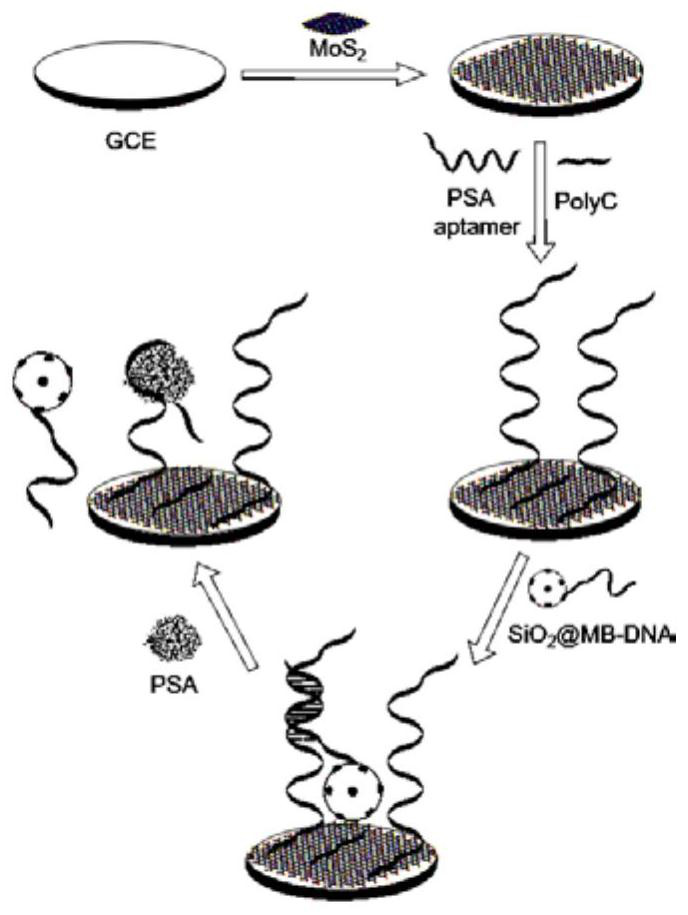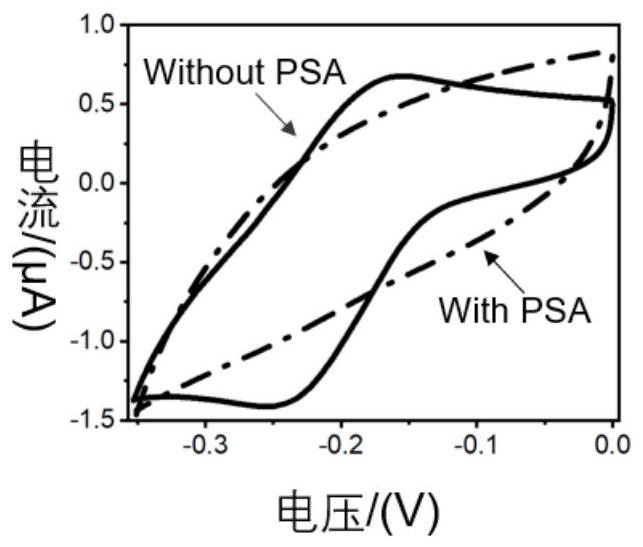Biosensor for detecting PSA, preparation method and application thereof
A biosensor, capture probe technology, applied in instruments, measuring devices, scientific instruments, etc., can solve the problems of low sensitivity and poor specificity, and achieve the effects of high sensitivity, low cost and improved sensitivity
- Summary
- Abstract
- Description
- Claims
- Application Information
AI Technical Summary
Problems solved by technology
Method used
Image
Examples
Embodiment 1
[0072] A method for preparing a biosensor for detecting PSA, the steps are as follows, and the flow chart is as follows figure 1 Shown:
[0073] (1) Clean the glassy carbon electrode:
[0074] The glassy carbon electrode (Φ=2mm) is sequentially coated with 0.3μm and 0.05μm Al 2 o 3 Polish the surface of the electrode into a mirror surface with polishing powder, then ultrasonically clean it with absolute ethanol and deionized water for 5 minutes, and dry it with nitrogen gas for later use;
[0075] (2) Add 12 μL of MoS at a concentration of 20 μg / mL 2 The suspension was added dropwise to the surface of the cleaned glassy carbon electrode, and incubated at 37°C for 40min;
[0076] (3) Add 12 μL of the mixed solution of capture probe ssDNA and polyC dropwise to the surface of the modified electrode, and incubate at room temperature for 10 h. The concentrations of capture probe ssDNA and polyC in the mixed solution of capture probe ssDNA and polyC are respectively 1μM and 1μM...
Embodiment 2~5
[0081] A method for preparing a biosensor for detecting PSA is basically the same as in Example 1, except that in steps (2) to (4), the dispersion (i.e. corresponding to MoS 2 Suspension, mixed solution of capture probe ssDNA and polyC, and SiO containing modified ssDNA labeled with methylene blue 2 Particle suspension), the addition amount, incubation temperature and time, the difference is shown in the following table, in the table, A is MoS 2 The amount of suspension added, the unit is μL, B and C are the temperature and time of incubation in step (2), the unit is ℃, min respectively, D is the added amount of the mixed solution of capture probe ssDNA and polyC, the unit is μL, E is the incubation temperature in step (3), in °C, F is SiO containing modified ssDNA and labeled with methylene blue 2 The amount of particle suspension added, the unit is μL, G is the temperature incubated in step (4), the unit is °C;
[0082] A B C D E F G Example 2 10 40...
Embodiment 6
[0084] For the application of the biosensor that detects PSA, its steps are as follows:
[0085] Establish a standard curve for PSA detection:
[0086] Take out the biosensor for detecting PSA prepared in Example 1, add 12 μL of PSA with different concentrations dropwise successively, incubate at room temperature for 2 h, then wash with PBS solution, blow dry with nitrogen, and use square wave voltammetry in PBS solution Investigate the change of current, and use it as the detection result, which can be used to make a standard curve for PSA detection. In SWV scanning, the pH of the scanned PBS solution is 7.4, the concentration is 10mM, and the scanning voltage range is -0.6~0V.
[0087] The sensor detects the change of the CV diagram signal of the target PSA as follows: figure 2 As shown, the SWV signal diagram obtained by detecting PSA with different concentration gradients is shown in Figure 7As shown, the PSA concentrations from a to k are 0fg / mL, 1fg / mL, 10fg / mL, 100f...
PUM
| Property | Measurement | Unit |
|---|---|---|
| particle diameter | aaaaa | aaaaa |
Abstract
Description
Claims
Application Information
 Login to View More
Login to View More - R&D
- Intellectual Property
- Life Sciences
- Materials
- Tech Scout
- Unparalleled Data Quality
- Higher Quality Content
- 60% Fewer Hallucinations
Browse by: Latest US Patents, China's latest patents, Technical Efficacy Thesaurus, Application Domain, Technology Topic, Popular Technical Reports.
© 2025 PatSnap. All rights reserved.Legal|Privacy policy|Modern Slavery Act Transparency Statement|Sitemap|About US| Contact US: help@patsnap.com



